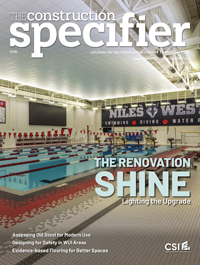Preparing for risk through resilience

Conclusion
Lessons learned on making long-lasting structures may not always be in vogue with designers seeking to push cutting-edge technologies in building materials. However, materials susceptible to fire, attack by insects, and wind or water damage, or those simply not strong enough to endure their surroundings, are not sustainable and can needlessly put lives and property at risk.
In the aforementioned FLASH publication, the group’s president Leslie Chapman-Henderson and senior policy analyst Audrey Rierson assert “it’s time to embrace the most essential aspect to resiliency—an uncompromising system of building codes and standards that guarantees a minimum level of home safety, durability, and sustainability.” It can literally be a matter of life and death to influence how elected officials, policy-makers, and decision-makers view the need for building codes and standards. Specifiers are in an important and unique position to educate clients, public officials, contractors, regulators, and the public at large on the importance of resilient building and the key role building codes play in achieving resilient communities.
Principled design and building professionals can make the case to policy-makers that they need to adopt robust building codes so their communities build to mitigate risks of known hazards. This will go a long way to break the cycle we find ourselves in today: inadequate building standards allowing construction based on the cheapest possible materials and methods, owners and insurance companies paying when these assemblies fail, and governments paying to put out the fire or cart off the debris before the builder comes back to construct the same type of structure as the one destroyed. Resilience matters.
Larry Rowland, CCPR, FACI, LEED AP, is manager of marketing and technical services for Lehigh White Cement Company. He is a member of the CSI Allentown Chapter with more than 25 years of experience in the material supply and construction trades. A Fellow with the American Concrete Institute (ACI), Rowland chairs the association’s Decorative Concrete and Plastering Committees and has served in numerous capacities with the Concrete Joint Sustainability Initiative, the Portland Cement Association (PCA), and the Architectural Precast Association. He can be reached at lrowland@lehighcement.com.








